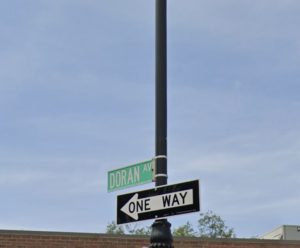Contemporary classical music comes to Ridgewood with ‘Laminaria’
By Stephanie Meditz
news@queensledger.com

Laminaria combines evocative contemporary classical music with costumes and other visual elements.
With Halloween around the corner, Ridgewood’s live music scene shifts towards dark themes reminiscent of the horror genre.
This Saturday, Oct. 15 at 8 p.m., Concetta Abbate and her 10-piece chamber orchestra will perform her folk-horror epic, “Laminaria,” at Footlight Underground at the Windjammer.
Through music and vocals, Laminaria tells the story of an underwater sea witch who emerges to the surface and ascends to the sky in death, only to be pulled back into the ocean.
The musical arrangement depicts the plot with its contrast between low, ominous notes and whimsical, borderline comedic elements.
“I always have a hard time explaining my genre,” Abbate said. “I think our ensemble is just covering all ends of the spectrum, music-wise. There are moments that sound a little more like a traditional cinematic orchestral score, and then there are parts of it that sound like you’re at a free improvisation show, and then there are parts of it like you’re listening to a rock band.”
Abbate, a classical violinist and vocalist, will be accompanied by an orchestra consisting of woodwind, string, brass and percussion sections.

The ten piece chamber orchestra consists of woodwind, string, brass and percussion sections.
Laminaria’s vocals and simplistic lyrics were inspired by medieval Gregorian chants and closely resemble incantations.
The orchestra also includes an array of homemade instruments played by Skip La Plante that create haunting sound effects without the use of technology.
“It’s really dipping into a lot of musical worlds and soundscapes,” Abbate said. “I think that’s what makes it so exciting because it’s really unexpected.”

Laminaria will be accompanied by modern dancers from Wendy Osserman Dance Company in Manhattan later this month. Photo by Alice Teeple.
The word laminaria means “kelp” in Latin, which is used to induce labor.
Kelp is also notorious for the destruction of boats and is known in New Zealand’s folklore as “the devil’s apron,” which is the title of Laminaria’s first movement.
“For me, this sea witch is trying to emerge and is kind of stuck in this crux between living and not living,” Abbate said. “I think there are also more tangible messages in the piece about access to healthcare and our mental health systems being so broken. So I think that this metaphor of this substance that is used to induce a change in life, whether it be birth or death, really encapsulated a lot of the message of the piece.”
Abbate was inspired to compose Laminaria during the COVID-19 pandemic when she watched many horror movies in quarantine.
“I started to question why I was so interested in horror movies and I realized that it’s a cathartic way to process traumatic events,” she said. “ And a lot of the time, the monster in the movie represents the trauma in itself, and it’s the physical embodiment of whatever real, terrifying thing is happening in your life.”
Abbate drew upon her own experiences of witnessing loved ones struggle with mental health issues and the healthcare system’s inability to help them.
“It literally looked like demon possession to me because when you’re a child, you don’t know the medical terminology for things,” she said. “And so I wanted to, in this piece, explore that childlike understanding.”
“I think the piece can be taken on many levels,” she continued. “You can come in and watch it and it could just be this silly, fun horror thing. Or if you wanted to seek out the deeper, cathartic meaning in it, if that feels relevant to the audience, I think that that part of it is also there.”
A native New Yorker, Abbate holds a master’s degree in music education from Columbia University.
She grew up on Long Island and has lived in multiple boroughs, but she now resides in Glendale.
“[The Windjammer] is just such a great local spot to get people in the neighborhood to know about the work,” she said. “I think it’ll be really fun at Windjammer.”
Tickets are available on a sliding scale starting at $10 at https://withfriends.co/event/15003568/laminaria or $12 at the door on the night of the performance.
After Laminaria’s Oct. 15 performance at the Windjammer, Abbate will perform the piece on Oct. 21 and 22 at Theater For The New City in Manhattan, accompanied by a modern dance routine choreographed by Wendy Osserman.
“When we did the first show, people were crying at the end of it. It’s a very moving experience to come and see this piece.”






















 Residents of Ridgewood, Glendale, and neighboring communities showed up for the long awaited 84th annual Ridgewood/Glendale Memorial Day Parade on Monday.
Residents of Ridgewood, Glendale, and neighboring communities showed up for the long awaited 84th annual Ridgewood/Glendale Memorial Day Parade on Monday.








